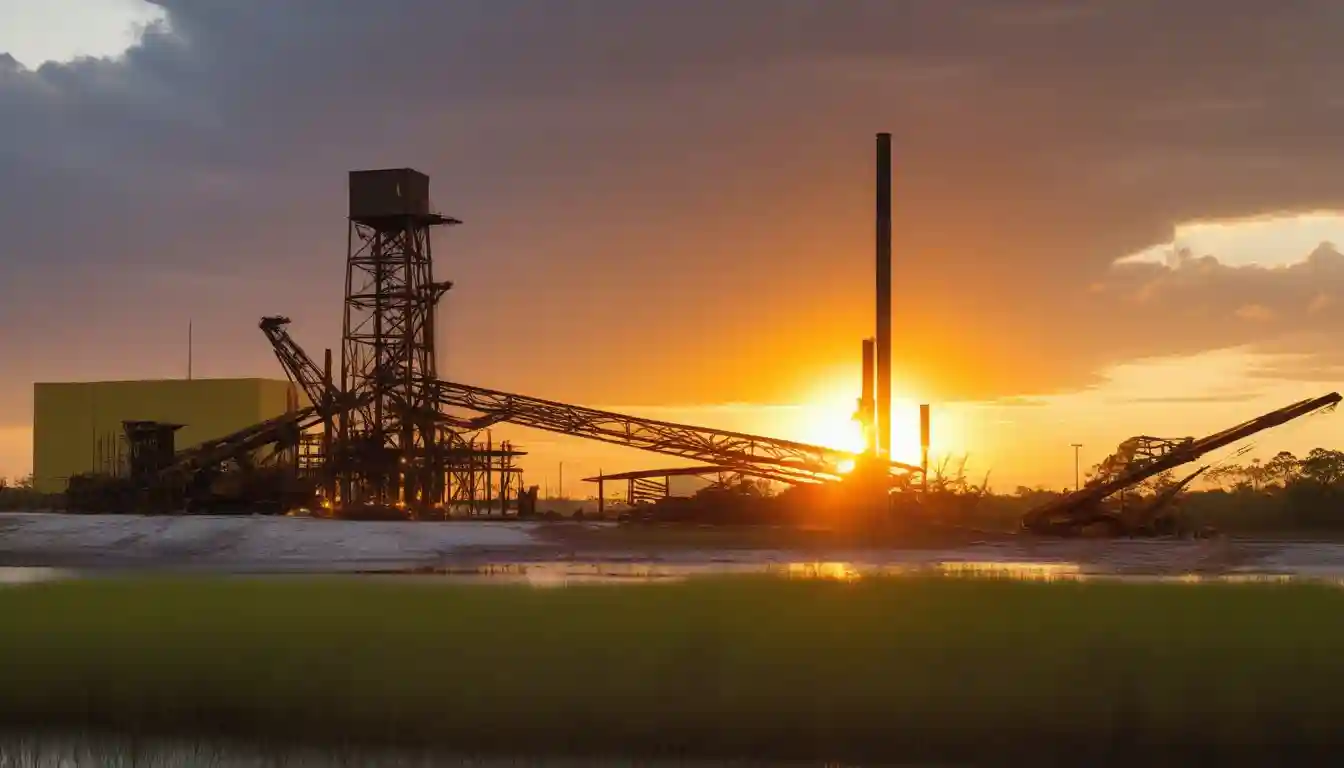
Pentagon Bankrolls America's Rare Earth Resurrection as Ucore's Louisiana Plant Takes Shape
Pentagon Bankrolls America's Rare Earth Resurrection as Ucore's Louisiana Plant Takes Shape
In the sweltering industrial zone of England Airpark in Alexandria, Louisiana, a nondescript 80,800-square-foot brownfield site has become ground zero for America's desperate bid to break China's stranglehold on critical minerals. By May 2026, this repurposed facility will house the Louisiana Strategic Metals Complex , where Canadian firm Ucore Rare Metals aims to achieve what many have deemed impossible: commercially viable rare earth processing on American soil.

America's Mineral Achilles' Heel Meets Pentagon's Pocketbook
The Pentagon's decision to inject $18.4 million into Ucore's Louisiana facility this past May represents an extraordinary peacetime intervention in commercial markets. This funding isn't merely another defense contract—it signals nothing less than an industrial policy revolution, reflecting Washington's growing alarm over China's 70% dominance of U.S. rare earth imports.
"The U.S. hasn't just outsourced manufacturing—we've outsourced the very building blocks of modern technology," notes one defense analyst who specializes in supply chain security. "What we're seeing now is a wartime-style mobilization in peacetime."
The Louisiana SMC is designed around Ucore's proprietary RapidSX technology, which the company claims achieves separation targets three times faster than conventional methods while reducing operating expenses by more than 20%. If successful at commercial scale, this technological leap could significantly narrow the 15-30% cost disadvantage that has kept American producers on the sidelines.
Silicon Valley Giants Join the Mineral Wars
The Pentagon isn't alone in its crusade. Just weeks after the Defense Department's announcement, Apple committed half a billion dollars to MP Materials, America's sole fully integrated rare earth company. This unprecedented investment will secure American-made magnets for Apple's devices and fund a first-of-its-kind rare earth recycling facility in Mountain Pass, California.
Both investments reflect a stark reality: despite their innocuous name, rare earth elements form the backbone of technologies ranging from smartphones and electric vehicles to precision-guided missiles and radar systems. These 17 elements with tongue-twisting names like neodymium, praseodymium, and dysprosium enable the miniaturization and performance of advanced electronics.
The market has taken notice. MP Materials' stock surged to $59.66 on Wednesday, up $1.44 with extraordinary volume exceeding 16 million shares traded.
Beyond Mining: America's Missing Middle
For industry veterans, the excitement surrounding Ucore's Louisiana facility stems not from what it mines, but what it processes. America's critical mineral challenge isn't primarily geological—it's industrial.
"We've been mining rare earths at Mountain Pass for years," explains a commodities strategist at a major investment bank. "But mining is just the first step in a complex value chain. Without separation and processing capacity, we're still shipping our rocks to China."
This "missing middle" of the supply chain—the chemical separation, refining, and magnet manufacturing—represents America's true vulnerability. The Louisiana SMC aims to fill this precise gap, potentially becoming North America's first independent toll separator of rare earth elements.
The Radioactive Elephant in the Room
The renaissance of American rare earth processing faces formidable obstacles beyond mere economics. Many rare earth deposits contain trace amounts of radioactive thorium and uranium, creating regulatory and waste management challenges.
Environmental standards that are significantly more stringent than those in China add to the cost differential American producers face. This creates what industry insiders call the "green premium"—the higher cost of producing materials in environmentally responsible ways.
"This isn't just about building factories," observes an environmental consultant who works with mining companies. "It's about rebuilding an entire ecosystem of expertise, regulatory frameworks, and waste management systems that disappeared decades ago."
Economic Crystal Ball: Winners in the New Mineral Economy
The economic impact of this rare earth renaissance extends far beyond Alexandria, Louisiana. The Pentagon's unprecedented decision to establish a 10-year price floor of $110 per kilogram for critical rare earth elements fundamentally alters the investment landscape.
For professional investors, this price guarantee dramatically reduces the downside risk that has historically plagued Western rare earth ventures. Ucore's projections suggest the facility could generate approximately $30 million in annual EBITDA at its initial 2,000-ton capacity, potentially scaling to $75 million as production expands to 5,000 tons.
With Ucore's market capitalization hovering around US$85 million, the valuation appears to reflect significant expected growth but may still offer upside if the company executes on its ambitious timeline.
The Long Game: America's Mineral Independence Day
Despite the flurry of investment, experts caution that America's path to rare earth independence will be measured in years, not months. Even with accelerated timelines, creating a resilient domestic supply chain could take 5-10 years of sustained investment.
"China's dominance wasn't built overnight," reminds a senior policy advisor who requested anonymity. "They've been methodically executing their mineral strategy since the 1980s. We're playing catch-up in a game they've been dominating for decades."
The strategic significance of Ucore's Louisiana facility extends beyond its modest initial capacity. If successful, it provides a blueprint for scaling American rare earth processing and potentially attracts further investment from both government and private sectors.
Investment Horizon: Navigating the Rare Earth Renaissance
For investors eyeing the rare earth sector, Ucore represents one piece of a complex puzzle. While the company's RapidSX technology offers potential competitive advantages, the broader investment thesis hinges on the sustainability of America's commitment to reshoring critical mineral supply chains.
Several catalysts loom on the horizon: Ucore's final investment decision expected in Q3 2025, completion of RapidSX module fabrication in Q1 2026, and first production in May 2026. Each milestone carries both technical and market risk.
Industry analysts suggest a diversified approach to the sector, potentially pairing venture-style allocations to emerging players like Ucore with positions in more established names like MP Materials. The sector's volatility demands careful position sizing, with even bullish analysts recommending weights below 2% of portfolios.
While past performance never guarantees future results, historical patterns suggest that early entrants in successful industry transformations can deliver outsized returns. However, investors should consult financial advisors familiar with the unique risks of critical mineral investments before making allocation decisions.
As America's rare earth resurrection unfolds, one thing becomes clear: the intersection of national security, industrial policy, and environmental concerns has transformed what was once a niche commodity into a strategic battleground. For investors and policymakers alike, the stakes couldn't be higher.
Investment Thesis
| Category | Key Points |
|---|---|
| Deal Flow & Project Status | - DoD Phase-2 award (US $18.4M) validates RapidSX tech. - Brownfield site secured (80,800 ft²) reduces construction risk. - Production guidance: 2 kt (H1-26) → 5 kt (H2-26) → 7.5 kt (2027). - State incentives (≈US $8M) improve IRR. - Phase-1 CAPEX ≈US $75M (25% covered by DoD). |
| Technology Edge (RapidSX) | - 3× faster than conventional solvent extraction (CSX) with >20% lower opex and ⅓ footprint. - Potential to reset Western cost curves by closing China’s 15–30% cost gap. |
| Economics & Valuation | - Base case (2 kt): ~US $30M EBITDA, ~US $150M NPV10. - Expansion (5 kt): ~US $75M EBITDA, ~US $300M NPV10. - Current market cap: US $85M (C $114M), NAV coverage ~1.3× after risk adjustment. |
| Policy & Pricing | - Apple’s US $500M magnet deal signals OEM demand for ex-China supply. - Pentagon’s NdPr price floor (US $110/kg) improves bankability. |
| Competitive Landscape | - MP Materials: Scale + DoD off-take but faces magnet execution risk. - Lynas: Leader in heavy REEs but Australia-centric. - Ucore’s niche: Modular separation, first North American toll separator. |
| Catalysts (0–15 mo.) | - Q3-25: Final investment decision & offtake MOUs. - Q1-26: RapidSX module completion. - May-26: First REE feed. - H2-26: Ramp to 2 kt production. |
| Key Risks | - Scale-up failure: DoD KPIs provide early warnings. - Feedstock security: Multi-source strategy needed. - Funding gap: ~US $50M required pre-FID. - Price volatility: DoD floor mitigates NdPr risk. - Regulatory delays: Brownfield site helps but risks remain. |
| Investment Conclusion | - Speculative Overweight: 0.6× NAV, leveraged play on U.S. policy. - Position size: ≤2% portfolio weight. - Potential acquisition target for defense/EV firms. |
| Monitoring Checklist | 1. DoD milestone reports. 2. Offtake contracts (>50% pre-FID). 3. State/DOE grants. 4. Heavy-REE separation data. 5. China export-control changes. |
Disclaimer: This article presents analysis based on current market conditions and should not be considered investment advice. All investments carry risk, and readers should consult qualified financial advisors before making investment decisions.